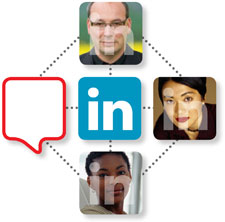
LinkedIn isn’t some stodgy place where people post their resumes. It’s a no- to low-cost database that is a rich source of information about potential major donors, board members, employees, and strategic allies.
Yet few nonprofits recognize LinkedIn’s potential as a research database or a means of getting introductions, according to Ditch Digital Dabbling: How Small Businesses + Nonprofits Can Master Online Marketing, research undertaken by Ventureneer and Message Medium. Nonprofits use LinkedIn less and they view it as less effective than small businesses and, frankly, small businesses aren’t catching the wave as they should. Only the digitally literate power-users are beginning to “get it.”
LinkedIn has 150 million affluent, influential members. They work in technology (15%), finance (12%), and 11% are entrepreneurs, according to Amodiovalerio Verde, a new media and technologies consultant. LinkedIn members are there to find people and to be found. If their passion overlaps with your nonprofit’s mission, they will welcome the opportunity to connect.
LinkedIn lets you search for the people who are passionate about your cause. It’s as easy to use as filling out a form. You can search for those passionate about your cause, within your geographic area, and have skills or values that are a fit for your nonprofit.
LinkedIn is a great place to find people you want to know. Sometimes you’ll want to get an introduction through a common connection but as John Brothers, Cuidiu Consulting, says, cold calls work, too. Sometimes it is better to go in cold. His firm specializes in helping nonprofits build capacity; frequently, fundraising is part of the services his firm provides.
For Brothers, success means building long-term relationships with funders. Before he makes an ask, he knows that the nonprofit he represents is a really good fit for the funder. He knows this because he meets with funders and gets to know them over a period of time.
Brothers has a checklist when taking off on a business trip and part of it is to search LinkedIn to find funders he’s always wanted to know. He feels awkward about asking his connections for intros to funders. People covet their relationships with funders so he opts to for a different approach: a paid access option.
The benefits of paying include access to more people — not just those who are within a few degrees of separation — additional search filters, seeing the full profile of everyone and, of course, the ability to connect with people directly through InMail.
Brothers writes a note to the prospect. In it, he points out the common passion for a cause he and the funder share. He suggests breakfast or coffee to get to know each other better. Brothers rarely gets turned down.
But Brothers uses LinkedIn to guide more than cold calls on prospective funders. He’s on the board of several nonprofits that host galas. Auction items are often needed for these events. When he wants free tickets to a show, sporting event or a cruise, he uses his LinkedIn connections to get that all important introduction.
Don’t think of LinkedIn as a technology, even though it is. Think of LinkedIn as an onramp to relationships with people who can become funders, board members, employees or strategic allies.
The online marketing survey gathered extensive data and benchmarks about how small businesses and nonprofits use online marketing and whether they are seeing results. For the executive summary, visit Ditch Digital Dabbling: How Small Businesses + Nonprofits Can Master Online Marketing.
